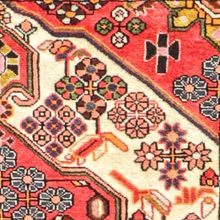Shahsavan Rug
| Shahsavan Rug | |
|---|---|
 Design of Shahsavan Rug (Rugman) | |
| General information | |
| Name | Shahsavan Rug |
| Original name | قالی شاهسون |
| Alternative name(s) | Shahsavan Carpet (Saveh Rug) |
| Origin | |
| Category | Tribal, Village |
| Technical information | |
| Common designs | Geometric, Tribal |
| Common colors | Blue, Crimson, Ivory, Yellow, Navy Blue |
| Dyeing method | Natural, Synthetic |
| Pile material | Wool |
| Foundation material | Cotton |
| Knot type | Symmetrical (Turkish) |
The Shahsevan are a tribe in north-western Iran. There are several groups of Shahsavan nomads scattered throughout the region. Shahsavan rugs are mostly geometric, with Caucasian style patterns and color schemes. These include a burgundy always, and beige. The navy used is very dark, looking almost black.
This historic region of Iran, as well as Turkey and Uzbekistan, have had the most significant influence on the development of the present-day carpet industry. Their bold style of weaving originates partly from Mongols who invaded Iran in the 13th century, settling there in the north-west. In these rugged mountains these tough nomads of both sexes have the talent and skill to weave dramatic, high-quality carpets by hand, with no use of modern technology whatever. In many cases, rug weaving is the family′s main source of income. They trade their produce with local merchants in nearby cities for the staples and necessities of life. A few of the regions and towns included in this region are Ardabil, Bakhshaish, Gharadjeh (Gharabagh), Goravan, Heriz, Mehriban, Sarab, and Shahsavan. Weavers of these regions usually use their own symmetrical Turkish double-knotting style, which tends to be dense and tightly packed. The asymmetrical Persian knot can also be seen in cities such as Ardabil. The pile of these rugs is thick, lustrous wool, handspun from local sheep, with strong cotton as the material of choice for the foundation. However, wool and goat hair can also be seen as the base of some Turkish tribal rugs. In a few regions such as Ardabil, silk is blended in with the wool pile to produce a splendid carpet. Natural vegetable and root dyes are mainly used for the coloring. These rugs are among the most sturdy and hardwearing, still using the weaving techniques employed thousands of years ago.
History
The Shahsavan are a well-known tribal group within the Iranian population. They are primarily situated on the Moghan plateau of the Eastern Azerbaijan Province in northwestern Iran. Some have immigrated to the Hamadan Province of western Iran and to the Varamin area not far from the capital of Tehran in north central Iran.
Shahsavan rugs from the Azerbaijan Province are known in the antique market from the early nineteenth century. They were recognized and became popular in the trade beginning in the 1970s. Shahsavan rug designs are geometric, with tribal influences from the Caucasus and Turkestan regions. The field layouts are allover or single medallion patterns featuring Star motifs, diamond-shaped lozenges, diagonal stripes, flower heads, animals, birds, human shapes, and other tribal designs.
Shahsavan rugs were made mainly for tribal daily use necessities. Weavings produced were Khorjin (saddlebags), Mafrash (pillows or small bags), storage bags, animal covers, decorative weavings, and other items. Shahsavan rugs have a wool foundation and a wool pile. The Turkish (symmetric) knot is used. Weavers also made flatwoven rugs in large quantities. Among the most collectible of Shahsavan weavings are the Soumak saddlebags, which feature striking designs and crisp colors. The same technique was used for large transport bags, and occasionally for other tribal items.
Some Shahsavan rugs were finely woven and possibly made by brides before marriage as a dowry, or as a gift to the Khans (area leaders). Antique Shahsavans are beautiful in coloration and in design execution. They are in demand by collectors in the market.
The colors used for the fields are reds, dark blues, ivory, and, occasionally, yellow and coral. These hues are interchangeable with the border. In addition, blues, browns, greens, gold, and cinnamon are used in the borders, medallion, and design elements.
Shahsavan weavings are usually made in tribal items, but occasionally runners are found in the market to approximately twelve feet in length. The grade quality ranges from medium to fine.
Another popular style woven by the northwestern Shahsavan tribe is the one used for Jajim (flatweave) Rugs. Jajim weavings are very beautiful in coloration, with vertical stripes and connecting geometric flowers, vines, and leaves, as well as S motifs and other tribal ornaments. The primary colors are reds, blues, gold, greens, browns, and ivory. Some fine examples are executed in silk.
The western Shahsavan tribes who live in the Hamadan Province weave rugs similar to Hamadan village styles. These rugs are known in the antique market from the late nineteenth century. They are categorized under the Mosul rug group. The rugs have a cotton foundation and a wool pile tied with the Turkish (symmetric) knot.
Shahsavan tribal rugs of the Varamin region are known in the antique market from the late nineteenth century. These rugs follow traditional weaving styles of northwestern Shahsavan weavings in design, technique, and coloration. Most of the rugs from this period have tribal Minakhani (rosette-linked trellis) patterns.
During the 1920s Varamin weavers switched to a city weave, with carpets on a cotton foundation and a wool pile. Floral designs were delineated in a higher-quality weave that became popular both domestically and for foreign export. This successful alteration had a great economic impact for the Varamin population.[1]
See also
| Search for Shahsavan Rug on Wikipedia. |
References
- ↑ Moheban, 2015, 525-526
Bibliography
- Abraham Levi Moheban. 2015. The Encyclopedia of Antique Carpets: Twenty-Five Centuries of Weaving. NewYork: Princeton Architectural Press.